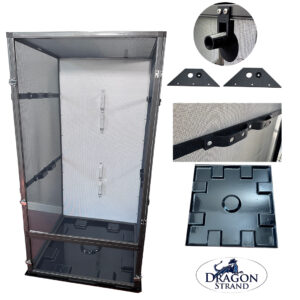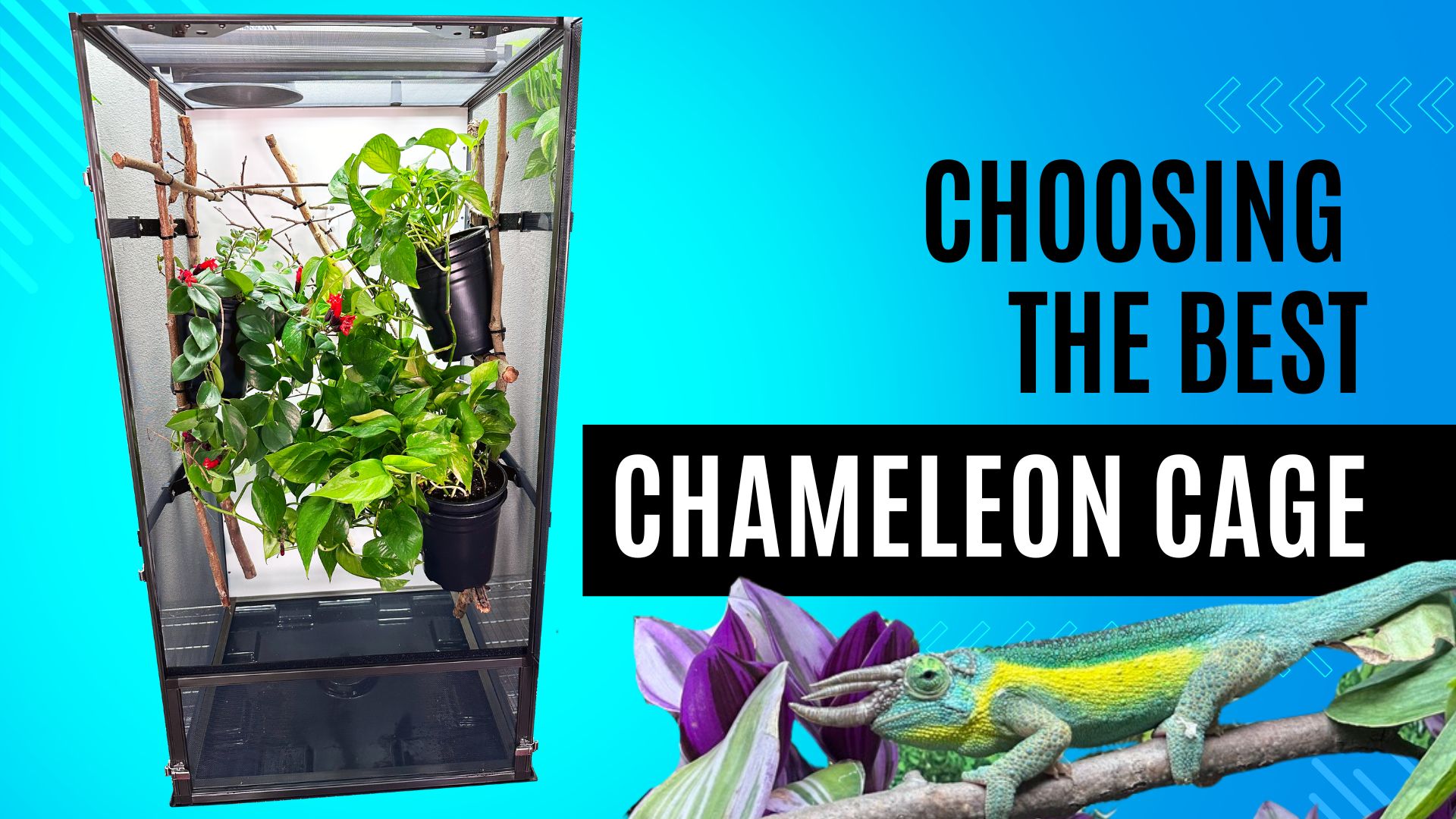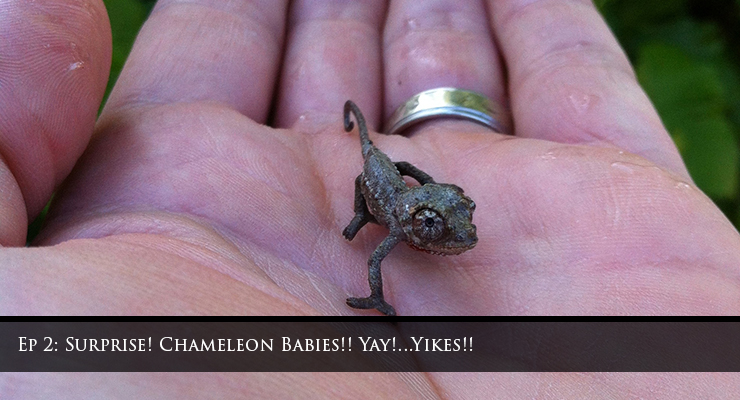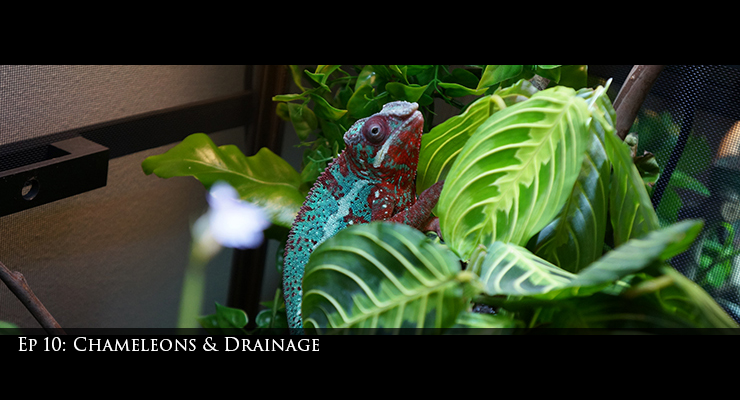Selecting the Best Chameleon Cage
We often don’t think about how we are going to set things up once we get our chameleon cage. After years of doing this, I’d like to share five things that can make the difference between annoyance and smooth sailing!
Note: This topic is discussed in the weekly Chameleon Academy Newsletter and is reviewed in both a YouTube video and a podcast episode. The video and podcast are separately produced and will provide different perspectives. Click here to join in with the weekly newsletter discussions: Chameleon Academy Newsletter sign up
Video Player
Podcast Player
Here are my five lessons learned for putting together a chameleon cage set-up.

1. Get the right size and shape of chameleon cage
The first consideration is size and shape of your cage. Bigger is better is a standard refrain for chameleon cages and it is 100% true. Of course, that comes with the assumption that the space is set up correctly. You can have a huge cage that is a very poor environment for chameleons. The intention behind the “Bigger is better” statement is not just the volume of the space available to the chameleon, but the number of effective microclimates the chameleon has access to and can regulate their body with. Which invites the secondary statement “A well structured smaller cage is better than a poorly set-up larger cage. So, the plot thickens. Instead of just buying a big cage we have to know how to set it up. Sigh. Well, I guess it’s good we have a podcast to talk about all of this year after year! But for this particular episode I want to explore it just enough so that you understand what is really meant in the statement bigger is better and how to make a cage selection decision. Because when we exist in the real world with real world compromises we have to figure out what the minimum acceptable size is. We have to figure out at what point “bigger” is not bringing much additional value. We have to choose a cage that fits in the real world space we have and, for most of us, is available as a product we can buy within our budget. We have to know why bigger is better to make sure we use the space effectively. So, the why of these basic concepts is critical for us to truly own the sound bite.
The bottom line is that you need enough space that the lights and humidity generating devices can provide effective gradients and the plant cover can provide different microclimates that are big enough for the chameleon to fit its body in. Now, that sentence is dense with concept so let’s unpack it.
Gradients are the progression of values from one extreme to the other. For example, heat goes from blistering hot at the surface of a 75W incandescent bulb to imperceptible in the corner of the cage over four feet away. And somewhere between these two extremes is the perfect temperature for a chameleon to bask in. The value of a gradient in what we are doing is that it gives our chameleon a choice as to how hot they want it. Now, how well they judge heat from an incandescent bulb is for another discussion. Let’s keep this to understanding gradients and providing choices for our chameleons.
Microclimates are areas where we have created an environmental condition and even an emotional condition. An example would be the thick middle layer of foliage where a chameleon can nestle itself inside and find a slightly higher humidity, lower light levels, and a more secure feeling. The more of these pockets of distinct conditions we can create, the more choices we give our chameleon.
So our enclosures need to be big enough to hold a number of gradients and microclimates that are big enough for our chameleon to fit its body in. This is why a proper chameleon environment will be bigger than a cage that contains the chameleon’s body. Instead of shopping for the smallest cage which will keep a chameleon on his stick, think less about containing the chameleon and more about creating the elements of a chameleon sanctuary with multiple areas with different microclimates and gradients. This is why we, the world creators, need space to work. Yes, the smaller the chameleon the smaller those spaces need to be, but there are also limitations of how small you can go because we have lighting/UVB/basking lights that are designed for larger cages. Don’t get a small cage that seems sufficient for the body Size of the chameleon and then put larger cage lighting on it. You won’t have room for the heat and UVB gradients. With chameleon cages, err on the side of bigger.
Let’s also talk about width. When I say wider is better than taller this is meant to communicate that chameleons are horizontal animals and they move back and forth through the trees more so than up and down. It does not mean that height is not important. Commercially, at this point in time, we generally have a choice between 2’x2’x4’ or 36”x18”x36”. Either of these will work as a minimum for the most common species, but, to illustrate my point, when we want to add more space to our 2x2x4 cage do we put the additional cage to the side or to the top? We put it on the side because that is how chameleons live and move. If a lizard lived on trunks of trees and went up and down the trunks then an upgrade would be to put the additional cage on top for a spacious 8’ living environment. But that would not do a chameleon much good because they live and move horizontally. You do need cage height to be able to create your gradients. For example, if your cage isn’t high enough for your heat lamp to dissipate then you are robbing your chameleon of the ability to make basking choices.
So when you hear me say wider is better than taller don’t think of removing height to make the cage wider. Keep your height and add width. Understanding this concept is most useful for people building their own cage. Don’t make this pillar to heaven. Allow your chameleon to spread out their living space. Don’t take away the height. Add width.

2. Get the right type of chameleon cage
When we dive into material construction of chameleon cages you have heard me differentiate using the terms Screen vs Hybrid vs Glass. I use these because they are relatively easy to understand and are in the ballpark of being accurate. In reality, these represent the amount of humidity and heat insulation the cage provides.
Screen represents ventilated cages which mimic the outside conditions. There is little difference inside the cage to the outside of the cage. You can create limited microclimates. Any heat source or humidity source affects the area directly in front of them when on, but the area quickly reverts back to ambient conditions when the source is turned off. Screen cages are excellent for areas – or times of the year – where the ambient conditions are close to what a chameleon wants. Notice my mention about times of the year. There are many areas that have certain seasons that are ideal for chameleons. If you had two cages, a hybrid for inside and a screen for outside you could take advantage of those naturally ideal conditions. Just another example of how understanding cage dynamics can bump your husbandry up a level!
Hybrid is a term that officially applies to any cage that brings in advantages of screen and solid sided cages. In practice, it usually represents PVC solid side cages which restrict airflow in order to retain humidity. I differentiate between PVC and glass, even though glass fits this description, because glass adds another dimensions. We will get to that. But for the sake of this discussion let’s accept that, for this discussion, when we say hybrid we are referring to a PVC sided cage. The top is screen and the front is either screen or is acrylic with a small screen vent at the bottom. If the entire front is screen then you are getting the benefit of mist retention and some humidity retention if you create humidity pockets with live plants against the solid walls. The full hybrid experience is when the entire cage is solid except for the top and a small vent by the bottom. This creates the chimney effect where the warm air under the lights rises and pulls in cool air from the bottom vent. This creates an air exchange that keeps the cage from becoming stagnant. The air exchange is slow enough that humidity can be retained. Since most commonly kept chameleon species do great with our standard human room temperature it is the humidity that is most often necessary to bump up. And that is what PVC hybrid cages do very well. Hybrid cages will also retain heat. The important thing to keep in mind with hybrid cages is that the husbandry has to change. Since both humidity and heat are retained you cannot simply leave a heat lamp, for example, on all day. That is screen cage husbandry. Remember how in a screen cage the heat is absorbed by the air in the entire room? In a hybrid cage the heat is absorbed by the small volume inside the cage and there is only so much heat being dissipated out. So more heat stays in. Thus you need to have the heat lamp on only until the chameleon is done warming up in the morning and then turn off the heat lamp. Use a hybrid cage when it is necessary to add either heat or humidity to your chameleon’s environment.
And glass represents glass cages which are great at insulating not only humidity retention, but also heat retention. Glass cages are, technically, hybrid cages, but I break them out into a class all their own because they are so much better at heat and humidity retention to the point where it is a powerful tool to create the proper environment or, if you do it wrong, an easy way to kill your chameleon. I break it out also because there is so much controversy in the chameleon community over using glass cages.
But, glass cages are only dangerous if you use them improperly. Chameleons can get a respiratory infection in screen cages or any cage with improper husbandry. Screen cage husbandry applied to a glass cage will be a disaster, but using a glass cage properly will provide a powerful tool to create the environment your chameleon needs when that is different than what is ambient conditions in the room.

3. Mounting branches and plants in your chameleon cage
One of the biggest challenges we chameleon keepers have had is to effectively replicate a slice of a tree canopy in our living room. There is no plant that can be potted up and grow both leaves and strong perching branches while confined in a 2x2x4 cage. A ficus benjamina tree can attempt this, but you end up with a big trunk taking up space in the middle of the cage and a tree that intends to grow to 50’ tall.
The ideal solution to this problem is to create a mounting grid which allows us to attach branches specifically chosen to be effective perching surfaces and use potted plants chosen specifically for their foliage for hiding and drinking. Whenever you purchase a cage you need to have a plan for how you will attach perching branches and get the plant foliage up where the chameleon can use them.
This was big enough problem for the chameleon community that I invented Dragon Ledges which screw into the aluminum frame and takes the weight of suspended plants and branches and carries it to the strong frame – bypassing the screen. The Dragon Ledges allow you to mount branches and potted plants along the sides of the cage which gives you the ability to create a floating garden type cage set-up. They are available through dragonstrand.com. Screen is not designed to be weight bearing. Yes, you can get away with some weight, but the more you put on the screen the closer you get to accidentally ripping the screen when you bump one of the items. If you do not have access to Dragon Ledges then firmly attached branches to the frames and build off the anchor branches. Before I created Dragon Ledges I would zip tie branches to the screen in multiple places to try to distribute the weight across multiple points. This was successful for branches, but when you start trying to put potted plants on the chances of a screen tear jump up dramatically.
Now, if you have a PVC sides hybrid cage this suddenly becomes easy because you can literally screw things into the cage sides and back. Take advantage of that ability! I know making holes in either screen or hybrid cage walls makes people pause, but do not consider these temporary modifications. The Dragon Ledges are a permanent addition and any branches or pots on the walls of your hybrid are probably going to be permanent as well. It is like writing in the margins of a book. Don’t keep it pristine. Modify it to serve you better!
Glass cages bring a bit of a challenge as there isn’t anything to attach branches or plants to, but you can create a branch anchor network by lodging them in place with silicone.
Each different cage type will have its unique challenges to getting branches and potted plants up where the chameleon can use them. Just have a plan for how you will do it before you select what cage you want to purchase

4 - How will you attach your chameleon cage accessories?
Make a list of all the equipment that you will be using for your cage. Mister, fogger, lights, feeder run cup. How will these attach? The Mist king mist nozzle attaches differently than the Exo-Terra Monsoon. And the misting mount is not included in the standard package. So, ask the question before you get to time to mount it! I would say that the misting nozzle mount is actually the number 1 surprise people get. They build the cage and then open the mister box and then realize they are missing a part! And, if you have ever tried to attach a fogger hose you know the experience could use some help. Of course, I solved this issue with the Dragon Strand cages by just including hydration mounts and a fogger input as standard so when you build the cage it is already ready for industry standard mist nozzles and fogger tube.
As far as lights, are you going to lay them on the top of the cage or will there be a shelf that they rest on or hang from? For basking lamps and UVB you will probably have to elevate them so that the energy going into the cage can be at safe levels. I suggest drawing out the cage top area and figure out where the lights will be placed. Figure out how things should be raised up if they need to be raised up. I like using deep dome fixtures for my basking light to keep it a couple inches away from the top of the cage and I either hang my UVB lamp from a shelf above or even just use wood blocks to raise it above the surface of the cage.
If you are getting a feeder run cup, how does it attach? Every manufacturer has their own take on mounting. Some have a hook, some have a ring, and some attach to the screen with pins or magnets. Make sure you know how yours attaches and bake that into your plan.
And, are you using any other accessories? A drip bottle? Is it too heavy for the screen top or is there enough room with all the lights? Whatever accessories you plan on having, connect the dots and purchase whatever mounting or connection hardware is necessary.

5. Have a drainage solution for your chameleon cage
And, finally, drainage…the #1 thing that is most likely to surprise people setting up a chameleon cage for the first time. All the mist and fog needs to go somewhere. Assuming it doesn’t go through the screen cage and onto your furniture, most of it will end up on the floor of your cage. Some cages are water tight. In this case, it will puddle and gather until you have a pond at the bottom of your cage. As peaceful as that may sound, in this case it isn’t so much. At the bottom of the cage is where the poop is and any escaped feeder insects and the last thing you want is for all that to mix in a puddle of water, much less a pond of water. In this case you will have to install a drain and get that water out of there. People have created drainage layers like dart frog keepers do, but for this to work it requires that you balance the water input into the system with how much your drainage layer can take without overflowing and saturating the soil. It can be done, but this requires a level of experience and skill that I wouldn’t recommend starting off with this solution in mind. Find a way to drain your cage. I do a series on Youtube with James Cross called the DIY Chameleon Guys and we touch on drains and such often.
Other cage designs have a floor panel that is not water tight so water will flow out of the cage. For this you set the cage on top of a drainage tray. With this system, I actually encourage the drainage by drilling holes in the floor panel when I use the plastic floors. You can use any tray that fits, such as dishwasher trays, water heater trays, or dog crate trays, but use stand off supports for the cage so it isn’t sitting in the waste water. My favorite way to empty the tray is to use a wet/dry vacuum. You can always add a 1/4” drip system valve to it if you want a gravity drain.
My solution with the Dragon Strand cages is to include a drainage tray with the cage. It looks good and has built in supports. I also include two floor panels. One is plastic and one is screen. The screen floor panel can be used when you have a clear floor as you would in the floating garden style when you use Dragon Ledges…see how this all fits together! When you use a screen panel for the floor you do not get puddling and it is easier to keep the cage hygienic. Having an extra floor panel also allows you to deep clean a floor panel and just replace it with the clean one while you are cleaning the dirty one. I chose the drainage tray approach over the sealed bottom approach because the drainage tray solution is self contained. You can place the cage anywhere and not worry about where a bucket will go.
Why don't all companies offer full featured chameleon cages?
So, a question that begs to be answered is – why don’t all the other caging companies offer all these features? Wouldn’t that make sense for ZooMed, Exo-Terra, Zilla, and the raft of off shore companies Amazoning or, now Temu-ing it into our online shopping? The answer is not really. This is a basic implementation of product marketing. And that is what I am professionally trained in. When you are creating a product whose main selling feature is price you have to justify each and every feature. And if your customer base is not aware of the benefit of the feature you have to then justify the added marketing expense to educate the customer about the feature. Your standard person walking into Petco for dog food and walking out with a chameleon is going to be turned off by a higher price. You say, but these are features they need! And, I hate to tell you this, but it is a more successful strategy to offer the base product and then either offer the accessories as upsells or else let them figure it out later. As long as the lack of a feature does not result in a return, the feature shouldn’t be put into a cage that uses price as its main appeal. If you are thinking that is taking advantage of customers that are not educated enough to know what they do and don’t need or are shocked that the welfare of the animal is not being taken into consideration then I would like to introduce you to the capitalist system. And also to human beings. Price is king for us. We get such a rush thinking we got a great deal we will compromise the quality or else are willing to pay more later for what we need as we hold on to the feeling of buying the original purchase for such a great deal. This is human nature. And appealing to human nature is the most successful approach in business. Everything other than price requires marketing dollars to educate the consumer. And some businesses do that exceptionally well. But it is also expensive. You never have to explain low price.
And I say all this without judgement. We NEED low cost cages. The ZooMed Reptibreeze XL is the most common entry level cage. Without it we would lose out on a chunk of community growth that would balk at buying one of my full featured-out-of-the-box cages. Yes, I lose sales to ZooMed because of price, but we aren’t really competing. The chameleon market is too small for it to be worth it to add cost. And the volume of a cheap cage is way to high for my hand made in the USA manufacturing. And my specialty is education. I will spend 45 minutes talking about the benefits of esoteric cage features to a small audience. That is what I do so I am uniquely suited to produce a full featured cage. ZooMed would have a difficult time supporting their factories with a full featured cage for such a small niche and I would have a hard time making any sort of volume that could support a national distribution plan. So, we all have our place. ZooMed is figuring out how to remove pennies from the design and manufacturing and I am figuring out what new features to add. For example, I just added a fogger input device as standard into every adult size cage and added cost to the Dragon Ledges to make them easier to assemble. And, every time I add cost, I have to increase the marketing to explain why that is a good idea. But, that is what I am here for. We all have our place.
In closing...
Keep five things in mind and have a plan for each. Obviously, I have taken these challenges and put all the solutions in the box. That is my answer for all of this. Purchasing a Dragon Strand cage supports the Chameleon Academy outreach so I thank you for your consideration. But if you are working with another cage then go through the checklist.
- is it the right size. The pictures can be misleading, especially if you are looking at offshore company marketing. Look for the actual specs.
- Is it the right type. This is something you decide before you even start looking. Basically, how much do you need to modify your environment? And that determines what level of ventilation you should consider.
- Branch and Plant Mounting. Figure out what the walls are made of and how you will get branches and plants where they are needed. Presumably, you will know the composition because you went specifically shopping for a certain type in step 2!
- Accessory equipment. If your cage does not come with the proper accessory mounting equipment then make sure your products do or you purchase them separately.
- Drainage. Find out of your cage of choice has removable floors, a sealed bottom, or whatever. Cage manufacturers are not used to people asking about the cage bottom and so this information isn’t usually on the product page. But it is important for you to be able to plan what you need for drainage.
Usually, when people get a chameleon cage they get the cage and then figure all this stuff out as they go along. But you now have the list of things to plan for so you can go through the process without the standard surprises everyone else gets.
And, with that, I think it is time to start closing it up. The best thing experienced community members can do is share experiences and topics like this to make the way easier for the newcomers. Of course, that is a big part of the purpose behind the Chameleon Academy.

Dragon Strand Cages
You have heard a lot about the Dragon Strand chameleon caging company. This is a company that I created to serve the specialized needs of the chameleon community. It is here that many of the firsts for the chameleon community were created. I design my cages to be full featured out of the box so you don’t get unwelcome surprises like needing to order an adapter. My main product line has both a screen cage and a hybrid cage. Sales of Dragon Strand cages directly support the Chameleon Academy outreach. Tap the links below to learn more about either version
https://dragonstrand.com/product/tall-screen-chameleon-cage-system/
https://dragonstrand.com/product/tall-hybrid-chameleon-cage-system/
Join me for a weekly discussion about chameleons
These topics are meant to be a discussion. If you would like to be part of the discussion, I introduce the topic in the Chameleon Academy newsletter which goes out every week. Each newsletter has a topic and I get feedback from the readers which I share in the subsequent newsletter and sometimes on the podcast and/or YouTube video. Yes, I share my decades of experience, but the Chameleon Academy has always been about the community and the perspective is greatly enriched when I hear from you. You can sign up for the newsletter here: Chameleon Academy Weekly Newsletter
And, with that, I think it is time for us to go out into that world and be awesome! Thank you for joining me on this journey to explore chameleon husbandry and the relationship between us and our chameleons. This is Bill Strand singing off. I will see you next time!












